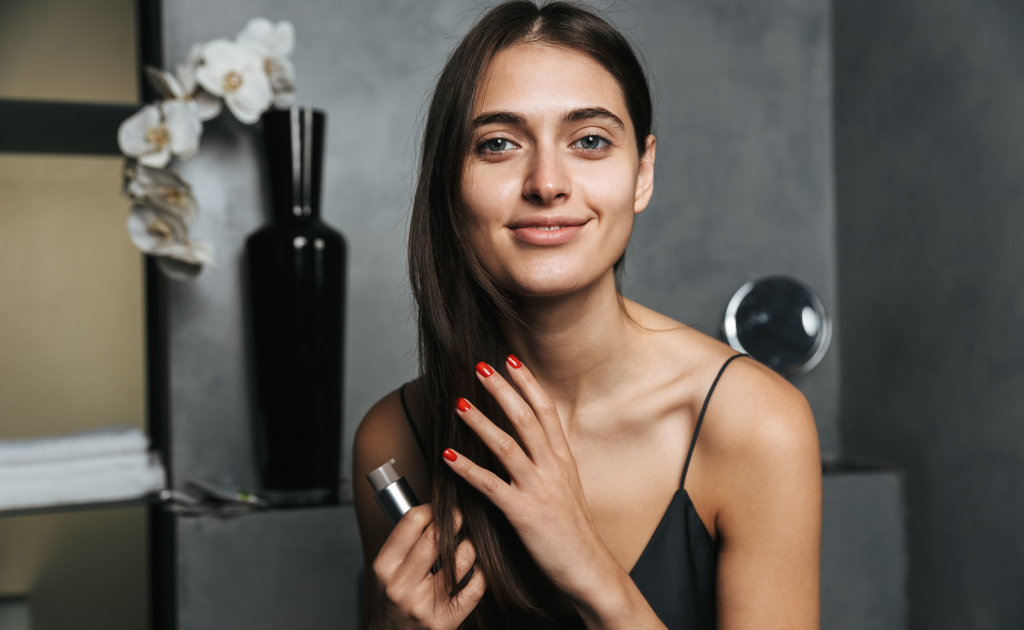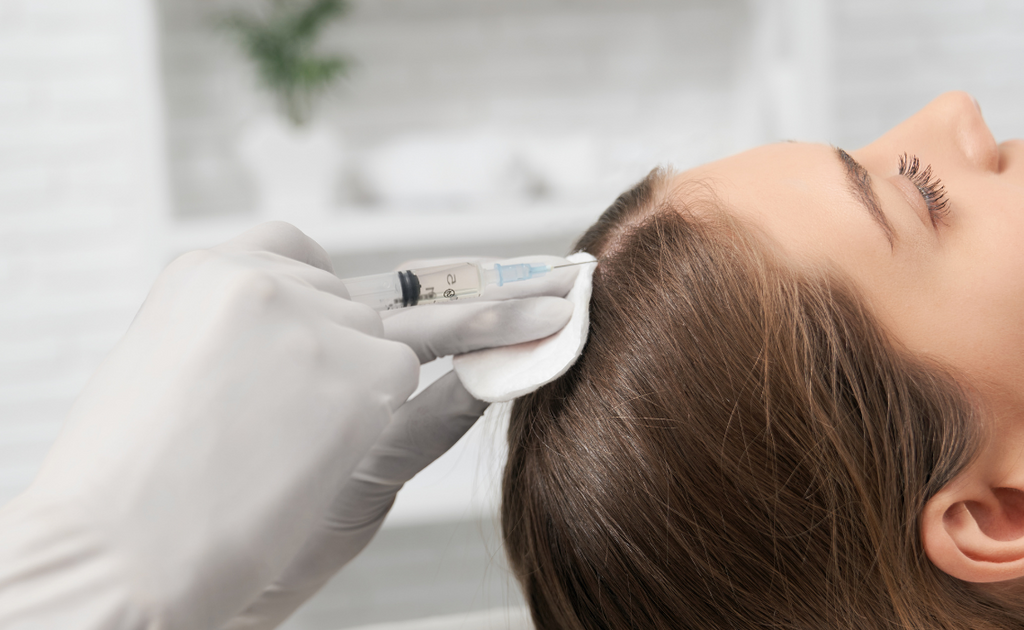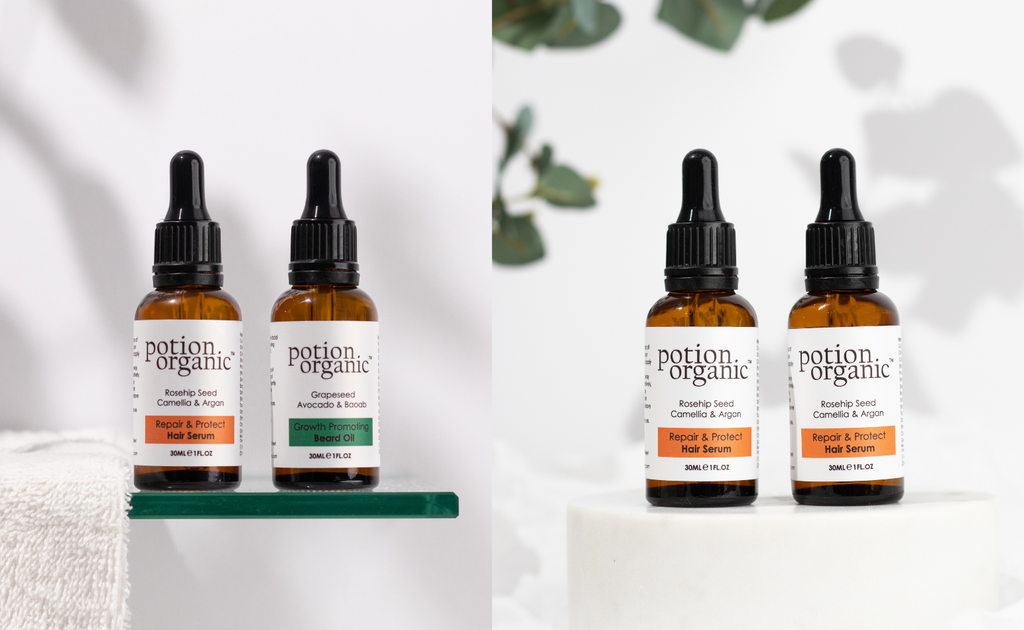How to Stop Your Hair from Falling Out and Thinning
The Ultimate Guide to Understanding Hair Loss and Finding Effective Solutions
Hair loss is a common issue that affects millions of individuals worldwide, transcending age, gender, and ethnicity. While it's natural to lose between 50 and 100 strands a day, excessive hair loss, also known as alopecia, can be a cause of concern.
Alopecia comes in various forms like Alopecia Areata, Alopecia Universalis, Frontal Fibrosing Alopecia, and Traction Alopecia, each with unique characteristics and causes. Factors contributing to hair loss range from genetic predisposition to underlying health conditions, stress, and even lifestyle habits.
Whether its noticeable thinning, a receding hairline, or patches of baldness, these signs should not be ignored as they are often the first indications of a more serious underlying issue.
 When you notice hair loss , it is crucial to seek the opinion of a medical professional right away.
When you notice hair loss , it is crucial to seek the opinion of a medical professional right away.
Understanding Hair Loss and Thinning
The hair growth cycle is a critical component to understanding hair loss and thinning. It comprises four stages: Anagen, Catagen, Telogen, and Exogen. The Anagen phase, also known as the growth phase, is the longest and can last several years. During this phase, the hair follicles are actively producing new cells that make up the hair strand.
Next is the Catagen phase, a short transition period lasting about two weeks, where the hair follicle shrinks and detaches from the dermal papilla. The Telogen or resting phase follows, lasting for around three months. In this phase, the hair does not grow, and the follicle rests.
Finally, the Exogen phase represents the shedding phase where the old hair falls out, and a new one begins to grow, marking the start of the Anagen phase again. At any given time, each hair on your scalp could be at a different stage of the growth cycle. When this cycle is disrupted, due to factors such as stress, hormones or medications, hair loss and thinning can occur. Understanding these stages can shed light on the root causes of hair loss and aid in developing effective treatment strategies.
Common causes of losing hair and thinning
These include:
- Genetic predisposition. This is the most common cause, and it typically results in male pattern baldness or female pattern hair loss.
- Stress. Hair follicles are highly sensitive to stress hormones like cortisol which can lead to excessive hair shedding and thinning.
- Hormonal imbalances. High testosterone levels, as seen in conditions such as polycystic ovarian syndrome (PCOS), can cause hair thinning in women.
- Nutritional deficiencies. Low iron, protein, and vitamin D levels are linked to hair loss.
- Health conditions such as thyroid disease, lupus, or diabetes can also contribute to hair loss and thinning.
 Sudden hair loss, patchy hair loss can be concerning and it is important to understand the underlying causes.
Sudden hair loss, patchy hair loss can be concerning and it is important to understand the underlying causes.
Signs of hair loss and thinning hairs
The signs of hair loss can vary depending on the cause, but there are some common symptoms to be aware of. These may include:
- Noticeable thinning or bald patches
- Receding hairline
- Excessive shedding when combing or washing your hair
- Hair strands that become thinner with each growth cycle
- Itchy scalp
- Burning sensations on the scalp
- Increased oiliness of the scalp
Lifestyle Changes for Healthier Hair
Importance of a balanced diet in promoting hair health
A balanced diet rich in vitamins, minerals, and protein is essential for healthy hair. Eating a nutrient-rich diet helps nourish your scalp and follicles, providing the nourishment needed for optimal hair growth. Foods like salmon, eggs, nuts, avocados, and leafy greens are packed with nutrients that can help support a healthy scalp environment.
Managing stress levels
Stress can be a major contributing factor to hair loss and thinning. Chronic stress increases the body's production of cortisol, which interferes with healthy hair growth. Learning how to manage your emotional well being is an essential part of developing healthier habits, promoting hair growth, and preventing further damage.
Regular exercise / Role of physical activity in maintaining healthy hair
Exercise can help increase blood circulation which carries vital nutrients to the scalp and encourages hair growth. Furthermore, regular physical activity is a great way to manage stress levels and promote overall well-being, both of which can contribute to healthier hair.
Physical activity doesn't just benefit your physical health, it can also help promote healthier hair. Exercise increases blood circulation which carries vital nutrients to the scalp and encourages hair growth.

Healthy habits for preventative care
To ensure healthy hair growth, it's crucial to practice preventative care with small lifestyle changes.
Chronic stress has a significant impact on hair health and can trigger a type of hair loss known as telogen effluvium. When the body experiences physical or emotional stress, it can push more hair into the telogen or shedding phase, resulting in noticeable hair loss. Stress can also exacerbate the symptoms of other types of hair loss, such as androgenetic alopecia and alopecia areata.
Additionally, maintaining a healthy lifestyle with regular exercise, a balanced diet, and adequate sleep can also help manage stress levels and support overall well-being. It's also important to seek professional help if stress becomes overwhelming; a therapist or counselor can provide valuable strategies to manage stress effectively.
Remember, your hair health is a reflection of your overall health and well-being. By taking steps to manage stress, you're not only helping your hair but your overall health too.
Temporary hair loss can be attributed to nutritional deficiency, vitamin deficiency or immune system issues.
Proper Hair Care Routine
Importance of choosing the right hair care products
Using the right hair care products is essential for maintaining healthy hair and scalp. The type of product used depends on individual needs, such as type of hair (curly, straight, thick or thin), texture (dry or oily) and lifestyle habits.
It's important to read the labels carefully when choosing a product as some may contain harsh chemicals that can cause further damage to hair. Natural, gentle ingredients such as coconut oil and jojoba oil are great options for hydrating the scalp and strands without stripping away natural oils.
Another important factor is to consider how often you wash your hair. Too much shampooing can lead to dryness and breakage, so make sure to use a mild formula that won't strip away essential oils. For those with excessively oily hair, a clarifying shampoo can help remove excess build-up and leave the scalp feeling clean and refreshed.
Using heat-protectant products before applying any heat styling tools is also important to keep hair healthy and protected from damage. Heat protectants create a barrier between the hair and the tool, preventing it from becoming overly dry and brittle.
Finally, regular trims can help keep hair healthy by removing split ends and maintaining an even length. Regular trims also promote healthier growth by keeping the strands in good condition and preventing them from weakening or breaking off.
 Further hair loss can lead to complete baldness, hence is necessary to seek hair loss treatment.
Further hair loss can lead to complete baldness, hence is necessary to seek hair loss treatment.
Techniques to Avoid Causing Hair Damage and Breakage
Prevention is always better than cure when it comes to maintaining the health of your hair. Here are some techniques that can help you avoid hair damage and breakage:
- Avoid Tight Hairstyles: Tight hairstyles, such as ponytails, buns, or braids, can cause stress on your hair and scalp leading to damage and breakage over time. This condition, known as traction alopecia, can be prevented by wearing your hair loose or in low, loose styles.
- Minimize Heat Styling: Frequent use of heat styling tools like straighteners, curling irons, and blow dryers can lead to dry, brittle hair that breaks easily. If you must use these tools, keep the temperature low and always use a heat protectant spray.
- Limit Chemical Treatments: Hair treatments such as coloring, perming, or relaxing can cause damage to the hair's protein structure, leading to weakness and breakage. Try to limit these treatments and seek a professional's advice when considering them.
- Avoid Harsh Brushing: Brushing your hair harshly can cause breakage, especially when your hair is wet as it is more elastic and prone to breakage. Always use a wide-toothed comb or a brush with soft, flexible bristles, and never tug or pull at tangles.
- Protect Your Hair from Sun Damage: Just like your skin, your hair can be damaged by the sun's UV rays. Wearing a hat or using hair products with UV protection can help protect your hair from sun damage.
By adopting these preventive measures, you can significantly reduce the risk of hair damage and breakage, keeping your hair healthy and strong.
 Losing hair occurs gradually, thinning hair can be attributed to medical conditions or genetics and family history.
Losing hair occurs gradually, thinning hair can be attributed to medical conditions or genetics and family history.
Medical Treatments and Procedures
Overview of F hair loss treatments
There are a number of medical treatments and procedures available for hair loss, ranging from medications to surgical options. The most common treatments are listed below.
Medications: The most commonly prescribed medications for treating hair loss include minoxidil (Rogaine) and finasteride (Propecia). Minoxidil is a topical solution that promotes hair growth while finasteride is taken as a pill and works by blocking the production of DHT, a hormone that can cause male pattern baldness.
Low-Level Laser Therapy (LLLT): Laser therapy has been found to be effective in treating certain types of hair loss, such as alopecia areata. This procedure involves using low-level laser light to stimulate hair follicles and promote the growth of new hairs.
Platelet-rich plasma (PRP) therapy: This is an injectable treatment that utilizes the growth factors found in your own blood to stimulate hair growth. The procedure involves drawing a person's blood, separating out and concentrating the platelets, then re-injecting them into areas where hair loss has occurred.
Hair Transplantation: This surgical procedure involves harvesting healthy follicles from one part of the scalp and transplanting them into areas affected by hair loss. It is considered a permanent solution to hair loss, but it can be expensive and may take multiple sessions for desired results.
Although there are many medical treatments available for hair loss, it's important to seek medical advice before opting for any of them. Consulting with a hair specialist can help you determine which treatment is best for your individual needs and can ensure the most successful outcome.
 Hair loss treatment can help regrow hair and get new hair, short hair while undergoing hair regrowth and strengthen the follicles.
Hair loss treatment can help regrow hair and get new hair, short hair while undergoing hair regrowth and strengthen the follicles.
Hair Restoration Procedures and Their Success Rates
Hair restoration procedures have rapidly advanced in recent years, providing individuals experiencing hair loss with an array of options to choose from.
These treatments are designed to restore the hair's natural growth patterns and improve the appearance of thinning or bald areas. The success rates of these procedures vary depending on several factors, including the individual's overall health, the extent of hair loss, and the type of procedure chosen.
Hair transplant surgeries, such as Follicular Unit Extraction (FUE) and Follicular Unit Transplantation (FUT), are among the most effective procedures, with success rates often surpassing 90%. These procedures involve the relocation of healthy hair follicles from donor areas to areas affected by hair loss, stimulating natural growth.
Non-surgical treatments like Platelet-Rich Plasma (PRP) therapy and Low-Level Laser Therapy (LLLT) have also shown promising results. PRP therapy, which uses the patient's own blood to stimulate hair growth, has a success rate of approximately 80%. Meanwhile, LLLT, which utilizes light energy to activate hair follicles, has a success rate of about 70%.
However, it's essential to understand that individual results may vary and that these procedures may not be suitable for everyone. A consultation with a hair loss specialist is crucial in determining the most effective treatment approach for your specific hair loss condition.
 If you experience hair thinning of you scalp hair, less hair is worth undergoing blood tests that cab reveal early signs medical conditions.
If you experience hair thinning of you scalp hair, less hair is worth undergoing blood tests that cab reveal early signs medical conditions.
Natural Remedies for Hair Loss
While medical treatments can be effective, there are also natural remedies that can help combat hair loss. These remedies are often preferred for their affordability, accessibility, and minimal side effects:
- Healthy Diet: A balanced diet rich in vitamins and minerals, particularly those known to boost hair health such as iron, vitamin D, biotin, and zinc, can help promote hair growth and prevent hair loss.
- Scalp Massage: Massaging the scalp can stimulate blood flow to the hair follicles, which can encourage hair growth.
- Essential Oils: Certain essential oils, such as rosemary and lavender, have been scientifically proven to promote healthy hair growth and reduce hair loss when gently massaged into the scalp on a regular basis. These oils work by stimulating blood circulation, nourishing the hair follicles, and providing a soothing effect to the scalp, resulting in stronger and thicker hair. Incorporating this simple and natural practice into your hair care routine can contribute to maintaining a vibrant and luscious mane.
- Herbal Supplements: Some herbs like ginseng and saw palmetto are believed to reduce hair loss and stimulate hair growth.
- Aloe Vera: Aloe Vera is well-known for its healing properties and is often used to soothe the scalp and combat hair loss.
- Castor Oil: Castor oil, derived from the castor bean plant, contains a high concentration of ricinoleic acid, a fatty acid known for its potential to strengthen and nourish hair follicles. By providing essential nutrients and moisture to the scalp, castor oil can promote healthier hair growth and improve overall hair health. Regular use of castor oil as a hair treatment may result in stronger, shinier, and more luscious locks.
It's important to keep in mind that these remedies may produce results if used regularly over a period of time. Additionally, natural remedies are not suitable for everyone, so it's best to consult with a healthcare professional before trying any of these solutions.
 Alopecia areata is an autoimmune condition associated with both genetic and environmental factors.
Alopecia areata is an autoimmune condition associated with both genetic and environmental factors.
In conclusion, addressing hair loss and thinning is of utmost importance because it not only impacts physical appearance but can also significantly affect self-esteem and emotional well-being.
A proactive approach can help manage the progression of hair loss and in some cases, even restore hair growth. This involves understanding the underlying causes, recognizing the signs early, and seeking appropriate treatment – be it medical interventions like hair transplants, medications, and therapies, or natural remedies like essential oils, scalp massages, and a nutrient-rich diet.
Natural Haircare Remedies at Potion Organic
Our Repair & Protect Hair Oil is made with all-natural and organic ingredients to give your scalp and hair the nourishment they need. It's packed with antioxidants, nutrients, and vitamins to repair damaged strands, promote new growth, and protect against further damage.
This versatile oil can be used for deep treatments or on a daily basis if you prefer. Just massage it into your scalp and comb through your hair for the best results.
And here's the best part - it strengthens your hair, adds flexibility, and restores natural shine without weighing it down. With fractionated coconut oil and argan oil, it also hydrates and protects your hair from environmental aggressors and excessive styling. Plus, the natural blend of castor oil, borage oil, and evening primrose oil nourishes your hair and helps reduce hair loss.
If you want to use it as a pre-shampoo hair mask, simply massage it into your scalp and dry ends, wrap your hair in a warm towel for 15-30 minutes, then shampoo and condition as usual.
References
- American Academy of Dermatology Association. (n.d.). Hair loss: Who gets and causes. https://www.aad.org/public/diseases/hair-loss/causes
- Mayo Clinic. (2020, October 14). Hair loss. https://www.mayoclinic.org/diseases-conditions/hair-loss/symptoms-causes/syc-20372926
- Harvard Health Publishing. (2019, June). Treating female pattern hair loss. https://www.health.harvard.edu/staying-healthy/treating-female-pattern-hair-loss
- National Alopecia Areata Foundation. (n.d.). About alopecia areata. https://www.naaf.org/alopecia-areata](https://www.naaf.org/alopecia-areata
- Cleveland Clinic. (2020, September 24). Hair loss in women: Possible causes and what you can do about it. https://health.clevelandclinic.org/hair-loss-in-women-possible-causes-and-what-can-be-done/
- National Center for Complementary and Integrative Health. (2018, August). Saw Palmetto. https://www.nccih.nih.gov/health/saw-palmetto
- Panahi, Y., Taghizadeh, M., Marzony, E. T., & Sahebkar, A. (2015). Rosemary oil vs minoxidil 2% for the treatment of androgenetic alopecia: a randomized comparative trial. Skinmed, 13(1), 15-21. https://pubmed.ncbi.nlm.nih.gov/25842469/

